New year, new weapons: What does 2025 hold for the Ukrainian defence industry?
Ukrainian arms manufacturers have the potential to scale up production significantly. But what will it take to make this potential a reality? Ukraine's Ministry of Defence allocated UAH 242 billion (approximately US£5.7 billion) to weapons procurement in 2022, a figure that soared to UAH 772 billion (roughly US£18.4 billion) in 2024.
Meanwhile, budgets for other security and defence agencies saw increases of 40-80% during this period, with tens of billions of hryvnias also directed to agencies that had not previously purchased weapons. Ukraine is pushing its defence industry to its limits while steadily increasing its military equipment budget each year. To achieve this, funds have been redirected from local government budgets, annual financial plans have been exceeded and resources have been reallocated from other budgetary items.
Advertisement:Weapons production has emerged as the only steadily growing industry.
Ukraine has no domestic sources for further increases in arms spending and the issue of opening up exports of military equipment has not moved forward. Does this mean that the defence industry has reached its peak? No, it doesn't.
There are still numerous avenues for growth and 2025 could outperform the previous year. However, this will require defence companies to expand into the production of new weapon types and components. At the same time, the government must focus on spending more efficiently and managing the market effectively.
New weapons are coming
The first challenge for the Ukrainian defence industry is to start producing weapons that Kyiv currently imports.
At the onset of the full-scale invasion, Ukraine allocated most of its weapons budget to foreign suppliers, as domestic manufacturers could not meet the diverse needs of the Armed Forces. Nonetheless, this dynamic is shifting, with state procurement increasingly focusing on the domestic market. Ukraine's Defence Procurement Agency told Ekonomichna Pravda that in 2024, 59% of all awarded contracts were granted to Ukrainian defence companies.
Having mastered the mass production of artillery, mortars, certain Soviet-calibre ammunition, some radar systems, spare parts for military equipment and electronic components, domestic plants have taken a bite out of government procurement dominated by foreign manufacturers. Kyiv has significantly reduced its reliance on imports for armoured vehicle production. Ukraine has achieved near-total self-sufficiency in the fields of drones and electronic warfare equipment.
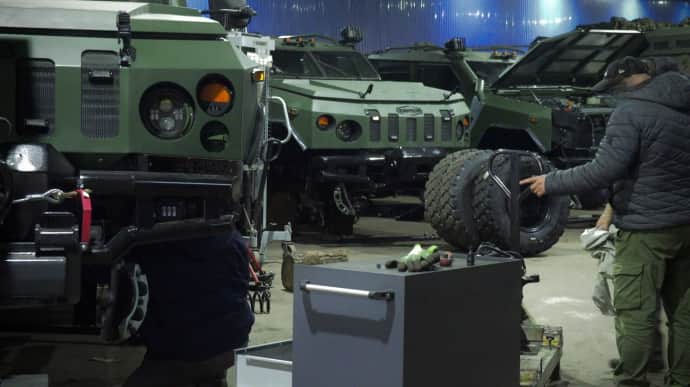 A repair shop for Ukrainian-made armoured vehicles Novator.Photo: Ekonomichna Pravda
A repair shop for Ukrainian-made armoured vehicles Novator.Photo: Ekonomichna Pravda
However, Kyiv still relies on foreign suppliers for about half of its weapons, as Ukrainian companies have yet to master the production of certain scarce items in the required volumes.
This primarily concerns NATO-calibre 155mm and 105mm ammunition, some Soviet-calibre munitions and heavy armoured vehicles. Trial batches of Ukrainian-made 155mm shells rolled off the production line in autumn 2024 and the production of Soviet-calibre mortar bombs and shells does not yet cover the needs of the defence forces. Production of wheeled armoured personnel carriers (APCs) remains limited, the ability to mass-produce domestic Oplot tanks is in doubt and Ukraine has yet to develop its own design for a tracked infantry fighting vehicle (IFV).
Organising large-scale production of such technological products in Ukraine is challenging but not impossible. The industry has taken a logical approach: partnering with foreign companies and engaging in licensed output of Western products. For example, Ukrainian Armor, a domestic defence company, proposed to the Ministry of Defence that assembly of the Spanish ASCOD APCs be set up in Ukraine, but so far, the initiative has not come to fruition.
Ukroboronprom, a conglomerate of multi-sector defence companies in Ukraine, announced the start of the assembly of the German Lynx APC. The possibility of localising production of the Swedish CV-90 IFV in Ukraine is said to have been considered, though only the purchase of these vehicles for Ukrainian troops has been confirmed so far. Ukrainian Armor signed an agreement with Czechoslovak Group of Czechia on the joint production of 155mm, 120mm and 105mm ammunition.
The company plans to ship 100,000 rounds in 2025 and 300,000 in 2026. Reports also surfaced that other Ukrainian businesses might start licensed production of NATO-calibre ammunition in cooperation with Germany's Rheinmetall, France's KNDS, Finland's Nammo and the US' Northrop Grumman. The rollout of licensed production is a slow process.
At first, Ukrainian companies will train staff under the supervision of partners, then assemble equipment from imported components and only as years go by will they be able to work on their own.
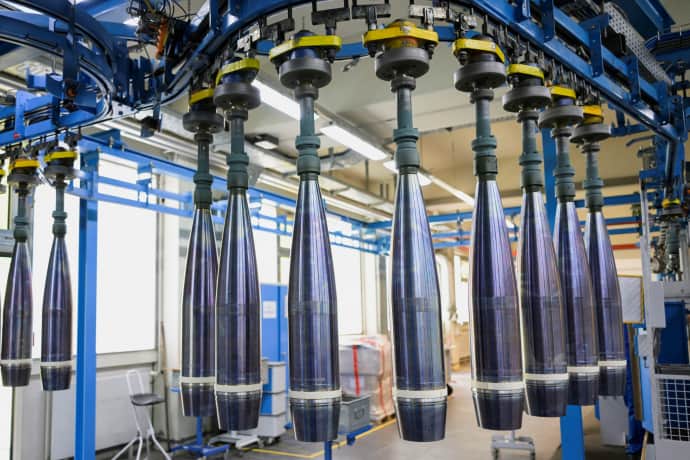 Production of 155mm shells at Rheinmetall.Photo: open sources
Production of 155mm shells at Rheinmetall.Photo: open sources
However, the game is worth the candle, as the quality of these products will be high and Ukrainian companies will become more financially stable, with greater prospects in the global market, thanks to their Western business partners. The shift of state arms procurement to the domestic market should be gradual. The worst thing the authorities can do is abruptly redirect all its procurement from imports to domestic producers without considering the actual capabilities of defence companies.
This year's issue with defective and undelivered ammunition from a state-owned plant is living proof that some companies may struggle to handle a surge in orders or could misrepresent their actual production capacities. The government's underestimation of these risks led to a shortage of ammunition supplies to the front despite the opportunity to secure contracts with foreign suppliers at the beginning of the year. Quality control also needs to be strengthened.
When launching large-scale production of new products, defective batches are inevitable. After low-quality mortar bombs were supplied to Ukrainian troops, Herman Smetanin, Ukraine's Minister of Strategic Industries, stated that companies would tighten quality control.
Component production is underway
On 20 December, Ukraine's Cabinet of Ministers (the government) adopted a protectionist decree, Weapons of Victory, which will require state customers to prioritise awarding contracts to companies whose products are in demand by the defence forces and produced in Ukraine for at least 50% of the cost. It is unclear how the percentage of domestic production (localisation) will be calculated and whether this will discourage manufacturers from improving quality and price.
It is obvious, however, that the production of components in Ukraine is increasingly becoming a significant factor for the state when planning arms procurement.
Increasing the percentage of localisation presents another potential growth point for the Ukrainian defence industry.
Ukrainian drones and ammunition are the most reliant on foreign components, with imports making up 70-90% of their production. As a result, a significant portion of procurement funding is spent abroad, product quality suffers and production time increases. Explosives, especially gunpowder, are key imported components in ammunition.
Ukrainian farmers have attempted to grow cotton for conversion into nitrocellulose and gunpowder. But building a complete production chain would take tens of millions of dollars.
Read also: Cotton and shells. Ukraine's first steps towards gunpowder production
In 2025, the Ukrainian government plans to start issuing grants for the construction of gunpowder factories, as announced by Deputy Prime Minister Mykhailo Fedorov. Since Ukraine began to take the first steps in this direction only in the tenth year of the war, the domestic market for explosives remains empty. The situation is similar with drone components.
Almost all Ukrainian First-Person View (FPV) drones rely on supplies from China. However, Anna Hvozdiar, Deputy Minister of Strategic Industries, says government customers will prioritise products with a higher proportion of Ukrainian-made components. This means that drone manufacturers will increasingly turn to Ukrainian-made electronics to gain a competitive edge.
This shift is prompted by issues such as defective batches of Chinese components, Beijing's frequent export restrictions and the demand for specialised military components that differ from the more universal imported alternatives. The Ukrainian company Vyriy Drone has launched mass production of components for FPV drones and assembles drones from these parts. Its director, Oleksii Babenko, told Ekonomichna Pravda that the number of components produced in 2024 is in the hundreds of thousands, while total market demand is around seven million.
The market for Ukrainian drone components is expected to boom in 2025, with prices expected to fall due to mass production. However, a certain regulation is slowing this process: in 2023, the Ukrainian parliament abolished VAT for imported components but not for those produced domestically. It turns out that Ukraine is helping Chinese manufacturers outcompete domestic ones by giving them a significant competitive advantage.
As a matter of fact, this is an invitation for Ukrainian component manufacturers to move abroad.
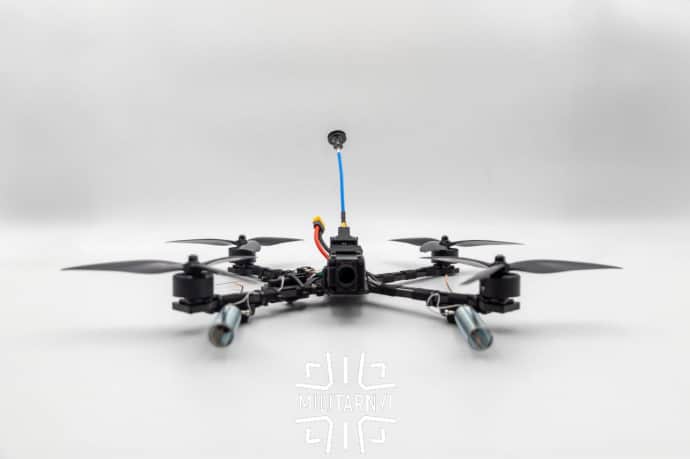 A UAV assembled by Vyriy Drone entirely from Ukrainian components.Photo: Militarnyi, a Ukrainian military news outlet
A UAV assembled by Vyriy Drone entirely from Ukrainian components.Photo: Militarnyi, a Ukrainian military news outlet
For over six months, Ukrainian defence companies have been calling for equal rules for both Ukrainian and Chinese manufacturers, but the Ukrainian parliament has been slow to make the necessary changes.
Funds are coming in from partners
The Zbroyari initiative, enabling Western partners to fund weapons production in Ukraine, is driving an increase in arms manufacturing. Partners can either finance Ukrainian Ministry of Defence contracts or sign direct agreements with manufacturers. All key government agencies, including the President's Office, have been involved in this diplomatic fundraising initiative.
In 2024, the government raised US£931 million for orders for domestic businesses. The largest donors were Denmark (US£351 million), the United Kingdom (US£67 million), Norway (US£45 million) and the European Union (US£436 million). The latter utilised proceeds generated by frozen Russian assets.
Ukrainian officials meticulously select domestic arms manufacturers to submit proposals to partners. To maintain the image of Ukraine's defence industry, they select companies with the lowest risks and the most in-demand equipment for the front. The partner country chooses the option with the best conditions for itself.
For example, Denmark signed a contract with a plant producing Bohdana self-propelled howitzers (SPHs), Lithuania funded Palianytsia turbojet drone missile systems and the Netherlands financed uncrewed surface vehicles and FPV drones.
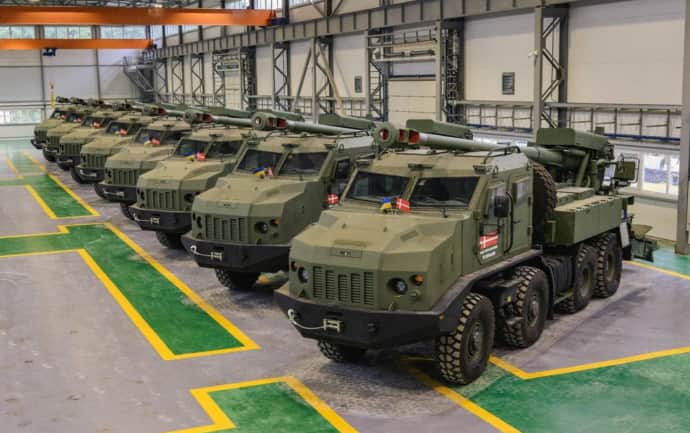 Part of the Bohdana SPHs ordered by Denmark for the Ukrainian Armed Forces.Photo: Defense Express, a Ukrainian military news outlet
Part of the Bohdana SPHs ordered by Denmark for the Ukrainian Armed Forces.Photo: Defense Express, a Ukrainian military news outlet
Maryna Bezrukova, Head of the Defence Procurement Agency, noted that companies must supply equipment without disruptions or quality issues, develop their production and technology and prove themselves as reliable partners to improve their chances of participating in the initiative.
Long-term contracts are still not out there
Since the start of the full-scale invasion, significant efforts have been made to reduce bureaucratic barriers hindering the industry's growth. Companies have benefited from higher profit margins, advances, simplified access to operations and decentralised ordering. However, to secure a new leap in quality, further changes are necessary.
The most common request from defence companies is long-term contracts lasting two to three years. The government currently limits contracts to "year-end" durations due to the constraints of the budget process. In the first months of the year, contracts are prepared and components purchased, allowing companies to operate at full capacity for several months.
However, once that period ends, manufacturers often experience downtime at their own expense until a new contract is signed. This slows industry development, as defence company managers are uncertain whether they will be able to compete for government contracts in the following year. As a result, investments in capacity building and new technologies become risky.
Read also: "Hell" for the Russians.
How Ukraine was creating a super-drone and ended up with a cruise missile The issue of the lack of long-term contracts is not new. Bezrukova explains that there is a legal option to sign agreements for up to 24 months, though the state lacks the funds to finance multiple years of production, especially when urgent needs at the front must be prioritised.
A compromise between the state and producers may be the way out, with the customer making payments in instalments while guaranteeing long-term orders. In return, manufacturers could gain access to affordable loans to cover operational costs.
The first concessional loan to a defence company at 5% per annum was granted only in December 2024.
Another challenge is the inflexibility of contracting rules. Given the rapid pace of technological advancements on the battlefield, committing to long-term contracts for drones with fixed specifications is risky.
Bezrukova explains that contracts allow for changes to product characteristics during production but do not permit price increases. Defence companies are left with two options: either modify the product at their own expense or deliver products that may no longer meet the latest standards. She believes that contracts should allow for dynamic adjustments, not only in technical specifications but also in pricing, provided there is a valid justification.
However, it remains to be seen whether such an initiative would comply with existing laws. Sometimes, even Ukraine's General Staff does not know whether it will need a particular weapon in a year's time. Therefore, to begin with, the state should draw up a list of evergreen equipment that will be the first to qualify for long-term contracts.
The Weapons of Victory decree, set to be published soon, is supposed to tackle this issue.
Technologies are moving forward
Ukrainian companies compete not only with each other but also with the Russians. As Russia rapidly adapts and develops methods to counter Ukrainian weapons, engineers are under pressure to continually push the technological envelope. The market is witnessing two key trends: an increase in R&D spending and deeper cooperation between companies.
There are numerous examples of collaboration between Ukrainian manufacturers. For instance, Kvertus, a company specialising in electronic warfare assets, has partnered with Ukrainian Armor to equip armoured vehicles with electronic warfare systems. Kvertus director told Ekonomichna Pravda that the Novator and Novator-2 vehicles, which are being mass-produced, are fitted with systems designed to counter FPV drones, with other armoured vehicle models soon to follow.
The mass-produced Ukrainian cruise missile Peklo is a result of collaboration between state-owned and private manufacturers. Ukrainian firms Vyriy Drone, Sine Engineering and Swarmer are working together on drone swarm technology, while OKO Camera has begun producing thermal imagers for drones developed by other Ukrainian companies. Meanwhile, ammunition producers have partnered with metalworking companies to manufacture bodies for UAVs.
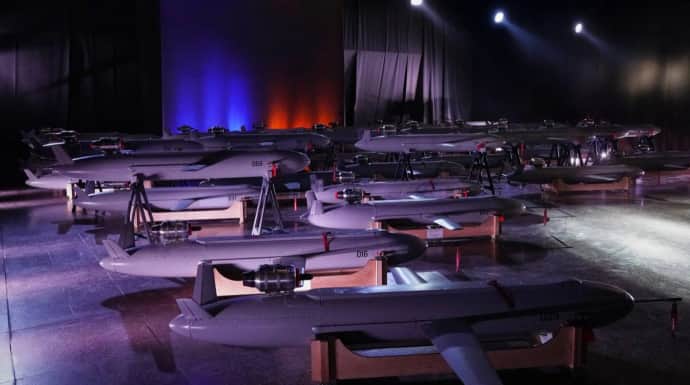 The Ukrainian-made Peklo turbojet drone missile systems.Photo: Herman Smetanin
The Ukrainian-made Peklo turbojet drone missile systems.Photo: Herman Smetanin
The state-owned Brave1 cluster plays a crucial role in facilitating communication between companies, gathering information about the market and the military's needs, and sharing this data with manufacturers, investors and all stakeholders in the defence industry.
Brave1 mainly focuses on unmanned systems and electronic warfare, providing development grants and helping companies with codification. Given the cluster's proven success over the past two years, it seems logical to gradually expand its scope to encompass a broader range of military products. Funding continues to be a significant barrier for defence companies.
With new technologies demanding higher investments and government orders remaining limited, many companies are turning their focus to the global market. Exports of military equipment are currently banned in Ukraine and the government is still working on a relevant policy. As a result, some Ukrainian companies are investing in factories and design bureaus abroad, opening their own export channels.
The issue of arms sales abroad is politically sensitive. However, if access to international markets remains closed, the partial migration of domestic producers to neighbouring countries is likely to persist. Translation: Artem Yakymyshyn
Editing: Susan McDonald